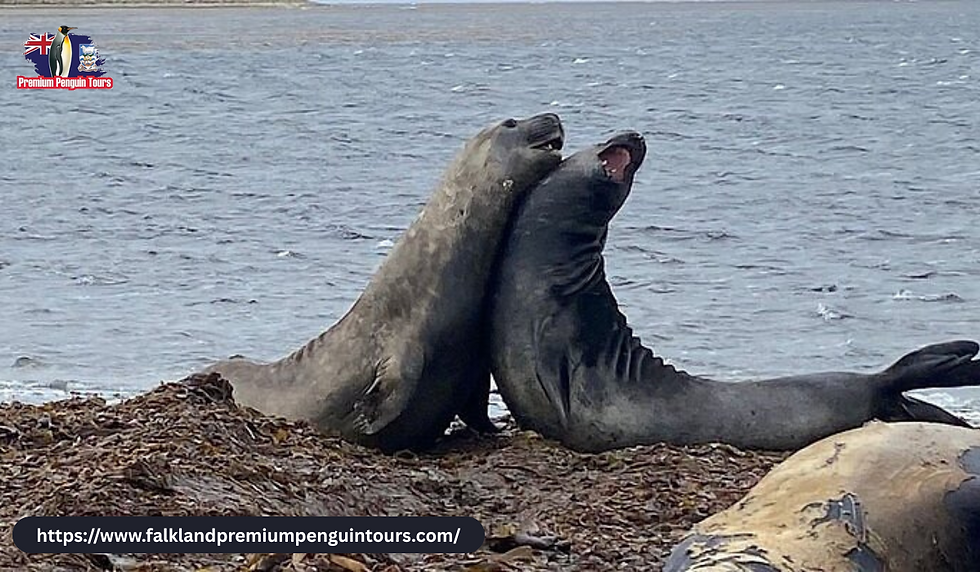Things to Do in Kelp Point (Whale Point), Falkland Islands
- Jimmy Anderson
- Aug 11
- 4 min read
Kelp Point is one of the Falkland Islands' best-kept secrets — a remote coastal paradise where wildlife, sea, and sky come together in breathtaking harmony.
From penguin colonies and towering cliffs to swirling kelp beds and rare seabirds, every step here reveals something wild and wonderful.
Whether you're a nature lover, photographer, or curious explorer, there's no shortage of unforgettable experiences. Here are the top things to do at Kelp Point that make it truly worth the journey.

Top 7 Things to Do at Kelp Point (Whale Point), Falkland Islands
Summary Table – Top 7 Activities in Kelp Point
# | Activity | Ideal For | Terrain | Key Tips |
1 | Coastal Walking Tour | Nature lovers & birders | Moderate | Windproof clothes, binoculars, early start |
2 | Penguin Watching | Wildlife enthusiasts | Easy to moderate | Stay quiet, visit Nov–Feb, bring zoom lens |
3 | Birdwatching at Cliffs | Birders & researchers | Rocky, uneven | Use tripod, avoid edges, ID guide |
4 | Photography of Kelp | Photographers | Slippery rocks | Use polarizer, golden hour shots, waterproof gear |
5 | Whale & Dolphin Spotting | Marine life lovers | Cliff & beach | Spotting scope, stay 30+ mins, Jan–Mar peak |
6 | Ocean View Picnic | Families & couples | Flat grassy areas | No littering, face ocean, stay quiet |
7 | Learn Local Ecology | Eco-tourists & students | Easy walk | Take notes, ask questions, great for kids |
1. Coastal Walking Tour
Take a walk along the windswept coast with our expert guides. The raw beauty of kelp forests, dramatic cliffs, and panoramic ocean views will leave you breathless. Along the way, you'll hear commentary on local flora, marine ecosystems, and historical landmarks.
🌿 Ideal for: Nature lovers & birdwatchers🥾 Terrain: Moderate – bring sturdy footwear
Tips:
Bring windproof layers — the coast can be breezy even on sunny days.
Binoculars will enhance views of seabirds and distant wildlife.
Ask your guide about Falklands war history along the cliffs.
Start early for the best lighting and fewer tourists.
2. Penguin Watching
Kelp Point is a sanctuary for penguins, especially Magellanic and Gentoo species. These charismatic birds are often spotted waddling across the beaches or nesting in the grassy dunes.
Ideal for: Wildlife enthusiasts & photographers Terrain: Easy to moderate – sandy patches and low dunes
Tips:
Remain quiet and still; penguins are easily disturbed.
Keep at least 6 meters away – use zoom lenses for close-ups.
Best time to visit: November to February (breeding season).
Early morning offers the most natural penguin activity.
3. Birdwatching at the Cliffs
Look skyward and you’ll spot soaring seabirds like Southern Giant Petrels, Skuas, and Rock Cormorants nesting along the cliffs. Kelp Point is a hidden gem for birdwatchers.
Ideal for: Birding enthusiasts & researchers Terrain: Rocky and uneven – hiking shoes recommended
Tips:
Carry a field guide or birding app to identify rare species.
Stay away from cliff edges — strong winds can be dangerous.
Use a tripod for stable, long-distance bird photography.
Best viewing hours: mid-morning to early afternoon.
4. Photography of Kelp Forests and Waves
Capture the swirling patterns of underwater kelp just offshore, with crashing Atlantic waves and rugged coastlines as your backdrop — a perfect shot for landscape photographers.
Ideal for: Hobbyist & professional photographers Terrain: Easy to access beach with slippery rocks.
Tips:
Bring polarizing filters to reduce ocean glare.
Sunrise or golden hour enhances kelp textures.
Use drones cautiously – birds may be sensitive.
Weather can change fast – waterproof gear is a plus.
5. Whale and Dolphin Spotting
Offshore sightings of sei whales, Commerson’s dolphins, and Peale’s dolphins are common. Scan the waters — particularly during summer months.
Ideal for: Marine life lovers & eco-tourists Terrain: Cliff-top and beach access
Tips:
Use a spotting scope or long-range binoculars.
Peak whale season: January to March.
Stay for 30+ minutes – sightings are unpredictable.
Join a guided tour for higher chances of spotting.
6. Picnic with Ocean Views
Enjoy a peaceful lunch surrounded by wild Falklands scenery. Designated spots at Kelp Point offer fantastic views with minimal disturbance to wildlife.
Ideal for: Families, couples, and solo travelers Terrain: Flat grassy areas near cliffs.
Tips:
Pack out everything — no bins on site.
Bring a thermos; it's often cool even in summer.
Avoid loud music or noise to not scare wildlife.
Sit facing the ocean — dolphin sightings are possible!
7. Learn Local Ecology with a Naturalist
Join an eco-guide to learn about the native plants, kelp species, bird nesting behaviors, and conservation efforts in the region.
Ideal for: Students, eco-travelers, and curious minds Terrain: Light walking required.
Tips:
Ask about climate change effects on the marine environment.
Bring kids — it’s interactive and educational.
Combine with the walking tour for a full experience.
Why Visit Kelp Point with Us?
Our licensed guided tours offer you safe, respectful, and immersive access to Kelp Point. We prioritize wildlife conservation, education, and personalized experiences that connect you with the land, sea, and its creatures.
✅ 4x4 transfers from Stanley ✅ Local wildlife experts ✅ Photography guidance ✅ Eco-responsible practices
Frequently Asked Questions
Is Kelp Point suitable for children or elderly visitors?
Yes, with our private guided tours, we adjust pacing and stops to suit all ages. Terrain may require some mobility for hiking portions.
Is it possible to visit Kelp Point on your own?
No. Kelp Point is best accessed via licensed 4x4 tours from Stanley. Independent travel is not recommended due to remote location and lack of marked trails.
What should I bring on a Kelp Point tour?
Wear layered clothing, waterproof shoes, and bring binoculars or a camera. We also recommend sunscreen, snacks, and a windproof jacket.





Comments